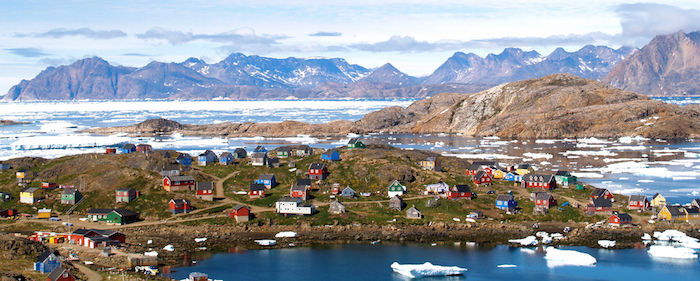Despite being covered by a massive, permanent ice sheet, Greenland has been continuously inhabited by humans for over a thousand years. Most modern Greenlanders are Inuit whose ancestors migrated eastward from Canada around 1000 AD, bringing technology like kayaks and dogsleds. They eventually settled on the coasts of the world’s largest island, hunting whales and seals. As well as their cultural and historical contributions, the people of Greenland carry important information in their genes. A study by Pedersen and colleagues published in the February issue of GENETICS examines variation in whole exome sequences of 18 Greenlandic Inuit individuals, showing the power this unique population could have for identifying rare genetic variants linked to diseases.
The patterns of genetic variation in any group of organisms, including humans, are closely tied to its size and history. The larger a population, the more genetically diverse it should be, and a migrant population will be less diverse than its source since its genetic diversity is a subset of the larger source population. Human populations from Africa are the most genetically diverse of all because their ancestors were the source for all other groups that migrated out of Africa to populate the rest of the world.
The ancestors of the Greenlandic Inuit journeyed most of the way around the world to get from equatorial Africa to the fringes of the Arctic Circle in Greenland: through Asia and across the Bering Strait to North America, and then across vast northern Canada to Greenland. This epic migration and settlement history is reflected in their genomes. Pedersen and colleagues show that the Greenlandic Inuit population has recently undergone a prolonged bottleneck of around 20,000 years, making it one of the historically smallest and most isolated human populations. When compared to much larger populations, the patterns of variation differ in specific ways.
The study found that Greenlandic Inuit have fewer genetic variants overall than other human populations tested so far, but the variants they do carry occur at higher frequencies. This might reflect the prediction that very small populations see increases in deleterious variation since natural selection is less effective in small groups. To explore this idea, the authors estimated how much of the genetic variation in the Greenlandic population is likely to alter protein function, including potential loss-of-function alleles and variants that alter the amino acid sequence of a protein. However, the evidence was conflicting, and the results depended strongly on the type of model used.
Nevertheless, the increased frequency of certain rare variants compared to other groups could prove a boon for disease association mapping by increasing the statistical power to detect links between gene variants and human diseases. One example is a single nucleotide change in the gene TBC1D4, which has been previously linked to type 2 diabetes. This particular allele is found at a much higher frequency in the Greenlandic Inuit population than other surveyed populations, even though type 2 diabetes is not reported to be more common in Greenland. The authors speculate this difference may be due to compensatory variation elsewhere in the genome since type 2 diabetes is a multigenic trait with many underlying contributing factors. In contrast, sucrase-isomaltase deficiency, a metabolic disease that prevents infants from digesting a certain sugar, is very rare in most populations but affects about 5–10% of people in Greenland. The exome data suggests this is due to the relatively high frequency of a particular frameshift mutation in the SI gene.
By any measure, Greenland is an isolated place. The people who first settled there used their creativity and ingenuity to flourish in a difficult environment, the same way humans have all over the Earth. Though genetic patterns differ subtly between groups, the deeper similarities show how closely humanity is connected. Thanks to this shared heritage, small differences between populations can serve as powerful tools for unearthing discoveries that will help us all.
Pedersen, C. E. T., Lohmueller, K. E., Grarup, N., Bjerregaard, P., Hansen, T., Siegismund, H. R., Moltke, I., & Albrechtsen, A. (2016). The Effect of an Extreme and Prolonged Population Bottleneck on Patterns of Deleterious Variation: Insights from the Greenlandic Inuit. GENETICS, 205 (2): 787-801. DOI:10.1534/genetics.116.193821













